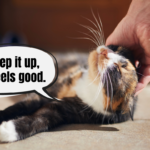Does the phrase: “My cat marks their territory” terrify you, fabCat? Don’t worry; it’s a completely normal reaction. After all, marking territory often conjures up images of cats urinating outside the litter box, spraying walls, sofas, and everything around. In practice, however, cats mark their territory not only through urine – they are territorial creatures, and to feel safe in their environment, they leave plenty of cues saying, “This is my home.” What methods do cats use to mark their territory, and why is it so important to them?
Cat – the Master and Ruler of Your Home
Territorial marking is an extremely important aspect of communication for cats. With the help of pheromones, they can inform other cats of their presence and convey specific information. It’s not about intimidating potential intruders; pheromones are the best way to send a message to others without direct interaction. In the world of cats, ownership of territory matters. It’s a matter of feeling safe. Of course, in our domestic setting, our couch tiger doesn’t have to worry about someone taking away essential resources, hunting their family, or depriving them of food. However, instincts are hard to deceive, and in cats, they are still very strong and not so different from their wild ancestors.
Territorial marking is entirely normal for both male and female cats, whether neutered or spayed. As you already know from the introduction, marking territory with urine is not the only method cats use. In their furry repertoire, you’ll find several very typical behaviors that help a cat assert their presence and provide a sense of security. What are these behaviors?
Non-invasive methods of marking territory:
Rubbing: Cats are masters at touching every inch of their surroundings with their bodies. A single stroll through the living room is enough for a cat to rub their cheek, body, or tail against the couch, table, dresser, chair, door frames, and, of course, a human’s legs. From our perspective, this form of territorial marking is entirely non-invasive, but for the cat, it’s an incredibly important way to set “signposts” around the entire house. By rubbing, a cat lets themselves know they were there before. It signals that the objects they see and feel in their environment are familiar, liked, and safe. Such olfactory calling cards have a significant impact on a cat’s well-being.
Kneading: Blankets, piles of clothes, a sleeping hooman – cats will always find something to knead. While it is soothing and calming for them, it also plays a crucial role in marking territory. Under a cat’s paws are scent glands, and during kneading (and scratching, which we’ll discuss shortly), a cat leaves plenty of scent marks on the object. These marks convey information about how comfortable and safe the cat feels in that specific place at that particular time. So when your cat jumps on your lap to knead you, don’t push them away – it’s an honor to be marked by a cat’s paws!
Litterbox chaos: The “non-invasiveness” of this method may be a bit debatable, but we’re sure you’ll agree, fabCats, that leaving uncovered treasures in the litter box is far better than a cat doing their business outside it. Not every cat vigorously digs in the litter box, and while the choice of litter may be a factor, another likely reason is the cat’s desire to assert their position in the household hierarchy. You might be the owner on paper, but scent-wise, the cat rules the house.
More about choosing the right litter for your cat: https://blog.mykotty.pl/en/2021/06/22/what-youre-digging-around-in-cat-checking-out-different-types-of-cat-litter/
It’s worth noting that the litter box itself is one of the most critical resources in a cat’s home. Even if a cat neatly buries all their treasures, the litter box remains the olfactory center of a cat’s territory. How many times, fabCat, have you cleaned the litter box thoroughly and poured in fresh litter, only for your cats to immediately enter and conduct their business? It’s not about malice – cats love a clean litter box but also need to ensure it still belongs to them.
When a cat marks with urine
Marking territory with urine is more advanced, and unlike non-invasive methods, it’s worth addressing. Cat urine has an exceptionally strong odor, especially in intact males, and removing its traces is not an easy task. However, let’s be clear – urine marking can occur in any cat, including spayed and neutered ones. So, what does this form of communication mean?
It’s primarily the most explicit of all territorial marking methods. When a cat uses urine for marking, they likely have something crucial to communicate. It could be a way to show who owns the house (especially if there are many unfamiliar cats around, and your cat wants to let them know the house is already occupied), a response to stress and a sense of threat, or a way to attract a potential mate and signal readiness for reproduction. If your cat is marking with urine and it’s not a health issue, consult a behaviorist.
Marking through scratching
Finally, we’ve saved the method closest to our myKotty hearts: scratching. It’s one of the most natural and essential cat behaviors, and we shouldn’t deny it to our furry friends. Besides sharpening their claws and stretching their muscles, cats scratch to mark their territory. There’s a reason attractive scratching spots are typically in crucial areas of the house – sofas, carpets, and chairs. By scratching these objects, a cat wants to assert their presence and mix their pheromones with the scents left by hoomans. Scratching is also a visual way of marking territory – we might not appreciate the sight of damaged furniture, but for a cat, it’s a significant matter. Scratching marks are a high expression of feline happiness!
But does our furniture have to suffer from all this? Not necessarily. Although our home furnishings hold high value for cats, strategically placed scratching posts in the house can significantly reduce the problem of furniture scratching. And this is where myKotty scratchers come into play:
- Made from high-quality corrugated cardboard that absorbs odors like a sponge – one of the reasons why cats love it so much.
- Stylish and minimalist, allowing you, fabCat, to place them in the heart of your cat’s environment – next to the couch, in the middle of the living room, on a dresser, on a windowsill, or near the bed. This way, your cat will have less motivation to scratch your furniture because the scratching post is right there within paw’s reach, and you won’t have to hide it out of sight.
- Ideal for scratching, sleeping, and playing. Cats mark through scratching, but also by rubbing. A horizontal cardboard scratcher is the perfect spot for a cat – it can comfortably stretch and leave behind a plethora of scents and fur while scratching.
Don’t discourage your cat from marking territory.
Cats need to do it to feel safe and comfortable in your home. However, you can ensure their sense of security and belonging by properly preparing their environment, so that scratched furniture and cat markings don’t disrupt your home’s feng shui.
- Provide hiding places for your cat. These are essential when a cat wants to take a long, uninterrupted nap. The MIA cat house recommends itself to all fans of furrtastic cat hideouts.
- Create safe resting and observation spots – tall scratching posts, wall shelves, and horizontal scratchers on windowsills are all great choices! For the role of a window sill resting spot, we recommend our mobile scratcher TOBI – it will always be within paws’ reach, ready to be scratched and to collect cat scents.
- Don’t be afraid of scratching posts. We designed LUI, VIGO, and TOBI to fit seamlessly into any interior. Don’t neglect your cat’s furniture – your feline friends need their place in your home just as much as you do. So, while you have the couch, chair, ottoman, pouf, and a big bed, make sure your cat has an equally broad selection. Place scratchers in socially important areas – the living room, next to the couch and chair, in the bedroom near your bed, at the entrance to the living room, by the window, and even in the kitchen. Let your cat know it’s welcome in every corner of the house 🙂
- Remember about the litter box. Don’t hide it away in the darkest, most remote corner of the house. It’s the center of your cat’s life! Let it stand in an easily accessible spot from where the cat can rule their kingdom. If you keep the litter box clean, you won’t even notice it’s there.
And how do your cats mark their presence in your home, fabCats? Can you immediately tell there’s a cat living there when you enter? Head to our Facebook page and show us your cats’ favorite spots in the comments → https://www.facebook.com/myKottypl




